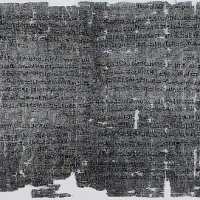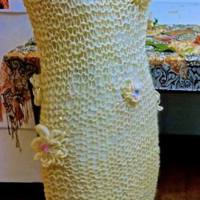Saturday, as I was walking along the road to the village, I heard a ‘thunk – plop’ – and saw, out of the corner of my eye, something black falling from a nearby tree. It was a very large, and dead, rat.

This is the tree-of-the-rat.
Then yesterday in reviewing emails, the The Egyptologists’ Electronic Forum (EEF)sent links to the following story in al-Ahram: “Returned rare sarcophagus of mummified rat to be displayed in Egyptian Museum Tuesday.”
Clearly, this was the Weekend-of-the-Rat.

‘Rat’ coffin recently returned by Germany to Egypt. Source: al-Ahram.
In fact, the little creature in the coffin is not a rat – but a shrew. These wee ‘rodents’ (they are actually of the mole family) were popular for use in magical spells and rituals during the Graeco-Roman era in Egypt. Indeed, as evidenced in a demotic magical papyrus from the 2nd or 3rd century C.E. – The Demotic Magical Papyrus of London and Leiden – shrews were used in a variety of the rituals and spells therein, some of which are given in this entry.
Based on extensive numbers of little animal mummies that have and continue to be found in specially built catacombs and other burial sites in Egypt, the group raising of animals to be sold for sacrificial purposes, including mummification and burial, appears to have been a thriving business during the Graeco-Roman era. Little animals were also sold to be used in performing magical rites such as those discussed below.
I am doing a separate blog on the micro-enterprise and the big-business of animal raising for sacrificial purposes in Egypt [22 May 2014]* Note –
- The use of ‘(?)’ following ‘shrew-mouse‘ in the following translation. may be because the word ‘3m3m’ – in Coptic, demotic and hieroglyphic – is not adequately verified.
- Repetition of certain phrases was a common feature in performing spells, and can be seen in several of the examples below.
COL. XIII [of the Demotic Magical Papyrus].
(11)[The uses (?)] of the shrew-mouse (?) to which it is put (goes):
You take a shrew-mouse (?), you drown it in some water; you make the man drink (12) of it; then he is blinded in his two eyes.
Grind its body (?) with any piece of food, you make the man eat it, then he makes a (13). . . and he swells up and he dies.
If you do it to bring a woman,
you take a shrew-mouse (?), you place it on a Syrian (14) pot, you put it on the backbone (?) of a donkey, you put its tail in a Syrian pot or in a glass again;
you let it loose (?) alive within (15) the door of a bath of the woman,
you gild (?) it (sic) and embalm its tail, you add pounded myrrh to it,
you put it in a gold ring (?),
(16) you put it on your finger after reciting these charms to it, and walk with it to any place, and any woman whom you shall take hold of,
she [giveth herself(?)] unto you.
(17) You do it when the moon is full.
Shrew in a coffin that has not been opened. 664 – 332 BC. This little fellow is currently for sale – follow the link. Yet another example of today’s thriving antiquities trade … http://www.artancient.net
Shrew mummy contained in the coffin ( depicted above) that is now housed in the Cairo Museum. Picture source: al-Ahram
If you do it to make a woman mad after a man,
you take its body, dried, you pound [it, you] take (18) a little of it with a little blood of your second finger, (that) of the heart (?), of your left hand;
you mix it with it, you put it(19) in a cup of wine; you give it to the woman and she drinks it;
then she has a passion for you.
You put its gall into a (measure of) wine (20) and the man drinks it; then he dies at once; or (you) put it into any piece [of food].
You put its heart (?) into a seal-ring(?) (21) of gold; you put it on your hand, and go anywhere; then it brings you [favour, love, and] reverence.
You drown a hawk in (22) a (measure of) wine; you make the man drink it, then he dies.
You put the gall of an Alexandrian [weasel] into any food, (23) then he [food consumer] dies.
You put a two-tailed lizard into the oil and [cook] it, and anoint the man with it; then [he dies(?)].
(24) You wish to produce a skin-disease on a man and that it shall not be healed, a hantous-lizard [and (?)] a hafleele-lizard, you cook them with [oil (?)],(25) you wash the man with them.
If you wish to make it troublesome (?), you put …… then it is troublesome (?). You put beer(?) . .. . .
(26) to the eye of a man, then he is blinded.
(27) The charms which you recite to the ring at the time of taking hold of the woman –
…..’Yaho, Abrasax, (28) may N. daughter of N. love me,
may she burn for me by the way (?).’
You . .. .. Then she conveys herself (?) after you;
you write it (29) again on the strip with which you wrap up the [shrew-mouse (?)].
![]()
‘3m3m’ – thought to mean ‘shrew’. Source: Brunner-Traut 1965, reproduced from Hutterer, R., 1994, with permission. Text from the Kahun papyrus.COL. XXIV.
(1a) For catalepsy (?) – another:
(2a) flour of wild dates (3a) which has been beaten up(?) with milk, (4a) ….(5a) you make them up together into a ball, (and) put in the wine.
(1)A medicament, when you wish to drug(?) a man – tested: –
(2) scammony root, 1 drachm, (3) opium, 1 drachm; pound with milk, (4) you make it into a ball and put it into some food (?), (5) which is cooked (?), and let him eat it; then he is upset.
(6) Another, when you wish to make a man sleep for two days:
– (7) mandragora root, 1 ounce, (8) liquorice ( ?), 1 ounce, (9) hyoscyamus, 1 ounce, (10) ivy, 1 ounce; (11) you pound them like (sic) a lok-measure of wine.
If you wish to do it cleverly (?) (12) you take four portions to each one of them with an uteh of wine, (13) you moisten them from morning to evening; you clarify them, (14) you make them drink it; very good.
Another, the fourth (?) : –
pips (?) [of] (15) apple, 1 stater (?), 1 kite, pound with flour.(16) You make it into a cake (?); you make the man eat it, whom you wish.
(17) A medicament for making a man sleep; very good:
– (18) pips (?) of apple, 1 stater (?), 1 drachma, mandragora root, 4 drachmas, (19) ivy, 4 drachmas; pound together; you put fifteen (20) uteh of wine to it; you put it into a glass glyt; (21) you keep it.
If you wish to give it, you put a little into a cup of wine, (22) you give it to the man.
Ivy:
it grows in gardens, (23) its leaf is like the leaf of shekam, being divided into three lobes (24) like a vineleaf; It (the leaf) is one palm in measurement; its blossom (25) is like silver – another says gold.
Another: gall of an Alexandrian weasel, (26) you add it to any food.
Another: a two-tailed lizard.
(27) A medicament for catalepsy (?) :
gall of cerastes, pips(?) of western apples, herb of klo, (28)pound them together; make into a pill, put (it) into the food(?).
(29) Another: you put camel’s blood with the blood of a dead man (30) into the wine; you make the man drink it; then he dies.
(31) Another: you put a night-jar’s blood into his eye; then he is blinded.
(32) Another: you put a bat’s blood;this is the manner of it again.
(33) Another: you drown a hawk in a jar of wine; you make the man drink it; (34.) then it does its work.
A shrew-mouse (?) in the same way; it does (35) its work also. Its gall also, you add it to the wine, (36)then it does its work very much.
You put the gall (37)of an Alexandrian weasel into any food; then it does its work.
You put a (38) two-tailed lizard into the oil and you cook it with it; you anoint (39) the man with it; then it does its work.
VERSO COL XXXII.
(1) To make [a woman] rave for a man.
(2) You take a live shrew-mouse (?), (3) and take out its gall and put it in one place, (4) and take its heart and put it in another place. You (5) take its whole body, you pound it very much;
(6) when it is dry, you take a little of the pounded stuff with a (7) little blood of your second finger, (that) of the heart, (8) of your left hand, and put it in a cup of wine (9) and you make the woman drink it, then she has a passion for you.
(10) You put its gall into a cup of wine, then she dies (11) instantly; or put it in meat or some food.
(12) You put its heart in a ring of gold and put it (13) on your hand; then it gives you great praise, love, and respect.
Source: Griffith F.Ll., Thompson Herbert The Demotic Magical Papyrus of London and Leiden. 1904.
Demotic, the last version of ancient Egyptian language prior to the development of Coptic, was used in writing the above text, and is also found in a number of legal and other documents for about 1000 years in the Nile Valley. See this link for more on the demotic language.
For more on magic and magical texts in the late periods of Egyptian history, see:
Jacco Dieleman, Priests, Tongues, and Rites: The London-Leiden Magical Manuscripts and Translation in Egyptian Ritual (100-300 CE). Religions in the Graeco-Roman World, – review.. Another writing of ‘3m3m’ , and as seen in the above header –Related articles
- Heka: The magic of ancient Egypt – a good, general introduction
- Diving shrews – heat before they leap (scienceblog.com)
- Alphabet Challenge :: E :: Elephant Shrew (trushin.wordpress.com)
- Falling lizards use tail for mid-air twist, inspiring lizard-like ‘RightingBot’(phys.org)





























Pingback: The Mouse becomes Vizier in Ancient Egypt | DIANABUJA'S BLOG: Africa, The Middle East, Agriculture, History and Culture
Pingback: Gift of a Shrew and Their Role in Graeco-Roman Egypt | DIANABUJA'S BLOG: Africa, The Middle East, Agriculture, History and Culture
Encountering your blog completely made my
day. You have no idea.
LikeLike
Merci! Thinking of performing a few shrew spells? 🙂
LikeLike